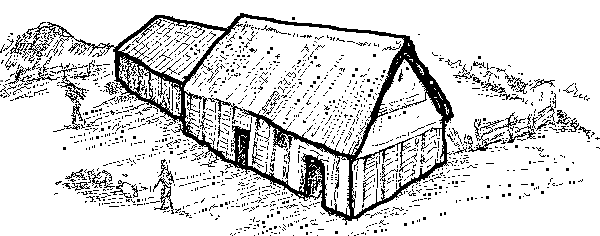

Anglo-Saxons arrived in Britain between about AD 400 and 600. Before the end of Roman administration in Britain in the reign of Constantine III in AD 407, foederati or "federates", who were mercenary troops from north Germany - where land was too scarce for a growing population - arrived by invitation to assist the Roman army. Later these newcomers remained, initially supporting the Romanised British population, but ultimately assuming political dominance.
Some of the earliest evidence for the Saxons in England comes from sites along the Thames, suggesting an initial Saxon strategy to protect this strategic artery. Evidence from Oxfordshire shows the continuation of a Roman (Christian) population in such centres as Dorchester, but also an early Saxon presence, here as at Berinsfield, Abingdon, Frilford and Long Wittenham.
The Romanised British must have been largely culturally assimilated into Anglo-Saxon culture, although as late as the 7th century a Celtic presence is visible in material remains such as the hanging bowl from Lowbury Hill.
Saxon material culture was not as highly developed as that of the preceding Roman period. Initially there was no building in masonry, municipal or military organisation, trade and industry, although the local manufacture of weapons and saucer brooches probably began in Oxfordshire around this time.
By the end of the 5th century, fresh Germanic immigration had ceased, and the existing population began to expand and spread. In Oxfordshire, Upper Thames Saxons expanded into the Cotswolds, travelling north up the tributaries of the Thames, and south into Wessex. Grave goods from these 6th-century communities show increasing wealth.
Some of the earliest evidence in England for the Saxon arrival comes from sites along the banks of the Upper Thames in Oxfordshire, demonstrating the importance of the river to the Saxons. The initial friendliness of the Saxons and Romanised British population is shown by the adoption of British inhumation by the new arrivals, who liked and kept Roman heirlooms.
At Dorchester-on-Thames in mid Oxfordshire, a small Roman fortified town given a ballista defence late in the 4th century, and the only major Thames crossing between Middlesex and the Cotswolds, a sub-Roman tyrant may have been replaced by a Saxon Chieftain whose kingdom-building would account for Saxons appearing at Berinsfield, Abingdon, Frilford and Long Wittenham.
The first wave of newcomers, whose origins lie in the north of Germany between the rivers Elbe and Weser, ceased by about 500 AD. In the second half of the 5th century, luxury goods found in Saxon graves at Abingdon and Brightwell suggest a second wave of more aristocratic newcomers from North Gaul or the lower Rhine. During the 6th century, immigration ceased but movement continued as the existing population expanded and spread. The Upper Thames Saxons spread west into the Cotswolds, up the local tributaries of the Thames, and south into Wessex
Despite contact with sub-Roman culture, the Saxons did not build with stone, organise towns or enjoy a monetary economy. The lifestyle was one of small farming communities, and throughout the countryside villages were founded which, because they are the basis for the pattern of English villages today, are invisible beneath later development.
However because of two aspects of the burial customs of the Anglo-Saxons - that their cemeteries were located at parish or estate boundaries in locations often not later developed, and that they like to be buried fully clothed, armed and equipped with food vessels and personal possessions - we know a great deal about their dress, society and manner of life.
Increasing wealth of the Upper Thames Saxons is suggested by larger and more exotic jewellery (glass, crystal and amber beads must have been traded across Europe), the specialisation of farms (the Saxon farmstead at New Wintles specialised in wool production, that at Purwell Farm, Cassington, cattle), and the rise of Anglo-Saxon kings. Perhaps the traces of large trench-built timber buildings noted at Dorchester-on-Thames in excavation, and at Drayton and Long Wittenham in aerial photographs, indicate royal villas and palaces; at Watchfield near Shrivenham the presence of a set of balance-scales with precious coins and weights in a grave may indicate royal administration.
Tantalising suggestions of an aristocracy in 7th-century Oxfordshire are intimated by high-status burial-mounds from the -low suffix (hlaew) in place-names, for example at Cutteslowe, and the physical evidence of a high-status ploughed-away barrow at Cuddesdon.
The Christian Saxon, or Middle Saxon period in Oxfordshire is marked by the arrival from Rome of the bishop Birinus in 635 AD to preach Christianity to the West Saxons. He baptised King Cynegil who gave him Dorchester as an episcopal see, the Saxon king’s palace becoming the bishop’s palace.
© 1998 Oxfordshire Museum Service, Setúbal Museums and the Benaki Museum